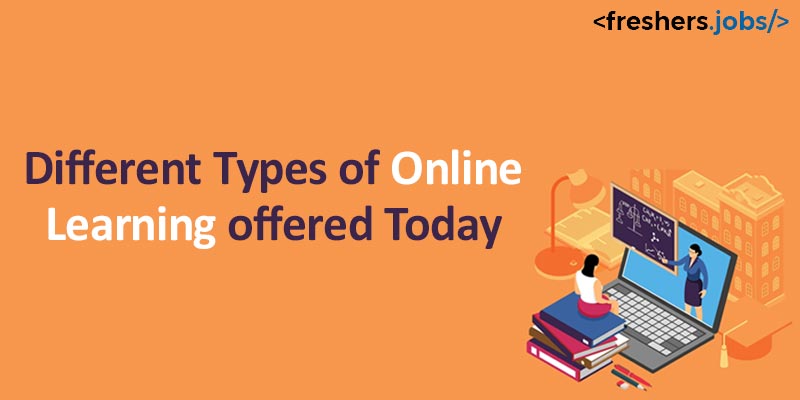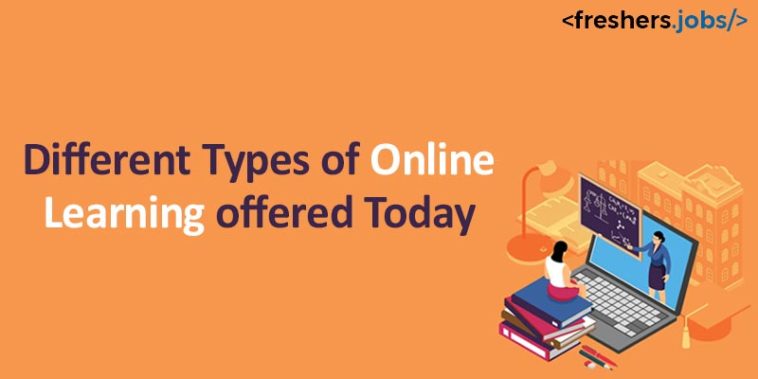Online learning, often known as eLearning, offers and facilitates learning and teaching through the internet. It offers educational opportunities to students and serves as an alternative to traditional classroom instruction. The greatest advantages of online learning are for those unable to attend sessions in person due to travel, financial, or other constraints. It is a thorough and adaptable learning method that can be accessed anywhere. Online classes, webinars, and virtual classrooms are just a few available types of online learning or e-learning formats.

The COVID-19 epidemic has significantly increased online learning systems use in recent years. Today, all types of students, including those enrolled in corporate training, rely on the internet to provide their course materials.
Over the years, the number of available delivery formats, options, and online learning programs has increased. They offer a choice of schedule, class style, and venue alternatives to accommodate the demands of the students. Top online institutes now offer a wide range of possibilities for students, both in job opportunities and education wise.
Importance of online learning
Online education has grown in significance over the past few years. More flexibility and self-paced learning are two advantages of online education that help students balance their studies with other responsibilities like freshers jobs and family, which are the objectives of online learning. Also, institutions and students can save money by using online learning. Online education can also give students access to a greater variety of courses and programs and aid in developing critical digital skills. Online education offers independent learning flexibility, personalised instruction, and better time management.
We shall see the different types of Online Learning
Online learning, e-learning or distance education are some types of online classes that have become increasingly popular due to their flexibility, convenience, and accessibility. Online learning refers to any form of learning that takes place over the internet, using digital technologies and tools. This blog will explore the different types of online learning and their features.
Having the courses learnt through online learning, you can tap into freshers jobs in Bangalore to get high-paying salary jobs.
Synchronous Learning
Synchronous learning refers to online learning in real-time, where learners and instructors interact simultaneously. This type of learning is typically delivered through live webinars, video conferencing, or chat rooms. Synchronous learning allows learners to interact with their instructors and peers in real time, which can be beneficial for building relationships and facilitating discussions.
Asynchronous Learning
Asynchronous learning, which is the modes of e learning refers to online learning on the learner’s schedule, without requiring live interaction with instructors or peers. Asynchronous learning materials can include pre-recorded video lectures, written text, audio files, and online quizzes. This type of learning allows learners to work independently, review materials multiple times, and fit their learning around their personal and professional commitments.
Blended Learning
Blended learning, or hybrid learning, combines synchronous and asynchronous e-learning process and methods. This approach typically involves online learning materials and in-person classes or workshops. Blended learning provides the benefits of both online and face-to-face learning, such as flexibility and personalized instruction, while also providing opportunities for social interaction and hands-on learning.
Self-Paced Learning
Self-paced learning refers to online learning that allows learners to work through materials at their own pace without the need for live interaction with instructors or peers. This type of learning is typically delivered through online courses or modules that learners can access at any time. Self-paced learning allows learners to work through materials at their own pace, review materials multiple times, and fit their learning around their personal and professional commitments.
Mobile Learning
Mobile learning, or m-learning, refers to online learning delivered through mobile devices such as smartphones or tablets. Mobile learning materials can include videos, podcasts, and interactive quizzes and are typically designed to be accessed on the go. Mobile learning allows learners to learn about the latest technologies on their schedule and from anywhere with an internet connection.
Massive Open Online Courses (MOOCs)
MOOCs are types of online learning courses designed to be open to anyone with an internet connection. MOOCs typically include pre-recorded video lectures, online quizzes, and discussion forums. MOOCs are often offered by the most prestigious universities and can provide learners access to high-quality educational materials at no cost. MOOCs are typically self-paced, allowing learners to work through materials at their own pace.
As most companies provide online learning and working system, you can look into the Infosys jobs for freshers, where they offer you learning opportunities.
Ways for Delivering Online Learning
There are various ways that mentors can deliver online instruction. Below, we will discuss a few different formats and the objectives of online learning for providing online education.
Video-Based Learning
Learning from a video or series of videos is called video-based learning. For people that prefer flexibility in their learning, this style works well. Typically, students can access videos from anywhere at any time. This style offers a 360-degree learning experience by fusing speaking, graphics, and animation.YouTube is a fantastic example of a video-based learning environment where users can watch courses on anything from knitting to computing.
Learning One-on-One
Not all online education is asynchronous or e-learning process. With one-on-one instruction, students can interact in real-time with an instructor or tutor. With more face-to-face connection with professors, this format enables students to express questions and resolve issues.
Group Learning
Group learning is well-exemplified in virtual classes, such as those provided by most online universities. These classes normally convene at predetermined times, and a designated instructor guides the class.
Pre-recorded lectures and other forms of media are frequently used in group learning classes to improve the learning process. Professors and instructors frequently use LMSs to submit grades, facilitate conversations, and record assignments.
Online learning platform’s advantages
Many students prefer to learn in person because online learning necessitates excellent time-management skills and self-discipline. Yet, there are a ton of advantages to distance learning as well. Many application of e-learning systems includes the following:
Affordable Options
It is frequently less expensive to take classes online than in person. No matter where they live, many schools and universities offer in-state tuition rates to all distance learners. Also, studying online saves money on lodging and travel expenses.
Online coding boot camps are a less expensive option than traditional degree programs for ambitious tech workers. And unfettered access to open-source learning resources online enables anyone to delve into a topic of interest.
Comfort and Flexibility
The objectives of Online learning or Online courses frequently let students study whenever it’s most convenient. This makes it simpler to maintain full-time work while going to school. Additionally, it implies that students can take classes at out-of-state universities without travelling or relocating.
Many Choices for all Learning Styles
Online learning environments provide options for all users. Group-based online learning combines the most significant aspects of in-person and distance learning for students who prefer the mutual trust of in-person learning. Conversely, folks who find group learning environments overwhelming may favour one-on-one online classes. Also, students who want much flexibility due to erratic job schedules can find it in video-based courses.
Conclusion
I Hope you are clear from the blog regarding the online learning types offered. Online learning provides learners a flexible and accessible way to access educational materials and acquire new essential skills. The different types of online learning have unique features and benefits, allowing learners to choose the method that best suits their individual learning needs and preferences. Whether you prefer synchronous or asynchronous learning, self-paced or blended learning, or mobile learning, an online learning option can help you achieve your educational goals to land a dream job with high freshers salaries.



